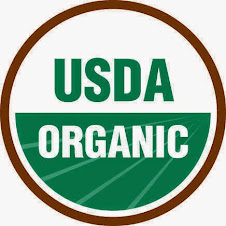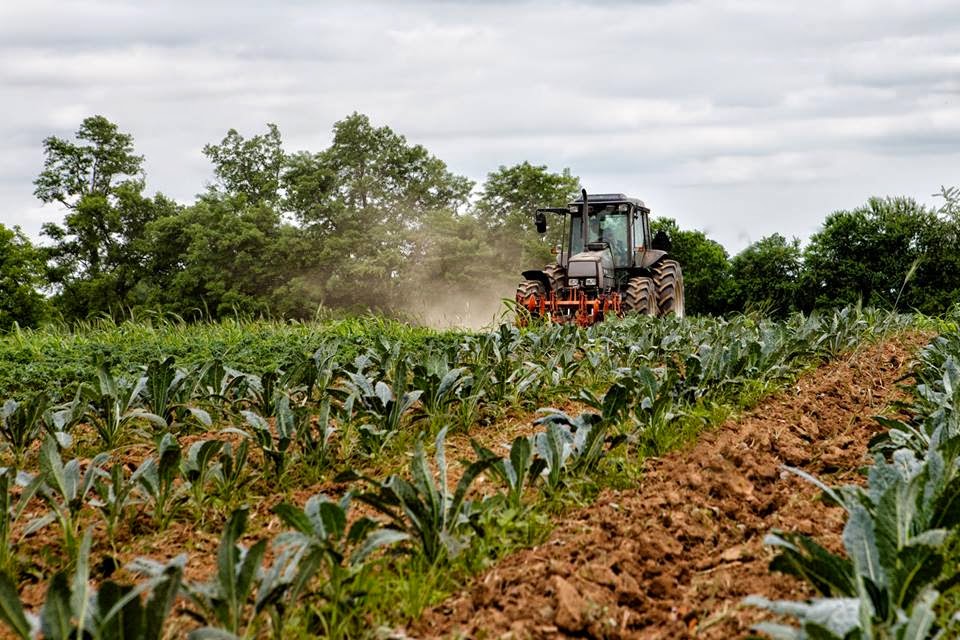The Buzz on Bees
By now many have heard one story or
another about the reduction in honeybee populations around the country,
including in our region of Kentucky.
Many theories continue to make headlines on what is happening to our
bees. As we learn in primary school,
plants need bees for pollination and reproduction. Many of our vegetables and fruits are the
direct results of flowers pollinated by honeybees. Imagine a healthy, green-leafed cucumber
plant, snaking along maybe 8 to 10 feet with many small yellow blossoms only
open to daylight for possibly one day.
Once the bee visits a blossom, the flower begins to grow into a tiny
cucumber, soon making a full sized salad slicer or possibly a future pickle.
Without bees, we would have luscious green
plants, but we would be wondering: Where is the Fruit? We unfortunately saw
this happen this season in our peppers and eggplant. The early blossoms were
not pollinated during the continuous days of rain. Bees stayed inside, and
blooms were blown off or damaged during windy rainstorms. Later rounds of
blooms fortunately were pollinated and now we are seeing fruit on the plants,
just several weeks delayed from the normal season.
Conversations among our oldest local
beekeepers center on the last ten years becoming very unpredictable with honey
production. Some of the loss in production is attributed to natural phenomena.
Early rainfall (like this season) keep bees from leaving the hives and getting
enough to eat. Wildflowers and natural bee habitats are abundant but flowers can
contain low amounts of nectar. And then there are the pollutants and pesticides.
Toxins get into the beeswax from farm and
lawn pesticides or air pollution.
Problems may spread from migratory bees that are trucked around the
country and rented out for pollination rather than kept for honey – as there is
less incentive to keep the wax frames well maintained. Urban development reduces
the available forage areas, well-maintained grass lawns do not provide the
desired diversity of plants, drought, heavy rains, mites, cell phones,
herbicides, the list goes on and on of things that can and will reduce honey production.
However, many beekeepers are optimistic
about honeybees and their habits as consumer awareness increases our shared
knowledge about the importance of bees. A conscientious beekeeper seeks out
organically managed habitats to locate hives. Good beekeepers will avoid the
uses of pesticides and chemicals, maintain a diverse foraging area for bees
with a variety of clovers or flowering plants, provide shade and access to
fresh water, replace the frames (where the bees build up honey) when needed,
use hygienic practices, and maintain and keep up their hives. We should all be encouraged that the benefits
of organic farming systems and organic home gardens will mitigate the stresses
on the essential honeybees. Our food will not grow without them!
In Your
Share :
Kale Greens
Fresh Herb
Okra
Bell Pepper
Hot Pepper
Potatoes
Summer Squash
Tomatoes
Garlic
Melon
Recipes:
Kale Pesto and Goat Cheese Pizza, a Heather Christo recipe
4
cups raw curly kale, stems removed
2
garlic cloves
juice
of 1 lemon
¼
tsp red pepper flakes
¼
C of olive oil
Kosher
salt
1
pizza dough
6
oz of goat cheese
olive
oil for drizzling
Preheat
the oven to 425°F. Roll the dough out into a large oval and transfer it to a
sheet pan. Drizzle the crust with olive oil and sprinkle with kosher salt and
put it in the oven to bake for about 10-12 minutes until golden. While the
crust is baking, combine the kale, garlic, lemon juice, and pepper flakes in
the bowl of a food processor. Pulse them until well pureed. Stream the olive
oil in with the processor running and run until very smooth. Season the pesto
to taste with kosher salt. When the crust is finished par baking, spread all of
the kale onto the crust. Add the goat cheese in chunks to the crust and drizzle
the pizza with olive oil. Bake the pizza for another 8-10 minutes until the
crust is very golden and the cheese is hot and a little melty. Drizzle with a
little extra olive oil (or truffle oil if you are feeling fancy!) and slice and
serve hot.
Kale and Apple Cake with Apple Icing, a Kate Hackworthy recipe that uses
local apples available at your farmers markets or organic apples grown in the
Western US as not many organic apples in our area. One baker that uses this
recipe posted online “The kale gives this cake such a bright green color and
the addition of applesauce means less oil needs to be used. This cake is
naturally sweet without being too sugary and has moist texture, as vegetable
cakes often do.”
For the Cake:
2
cups, packed fresh kale leaves, destemmed with stalks discarded
3
eggs
½
C grapeseed, vegetable, or coconut oil
2
tsp vanilla extract
½
C applesauce (or prepared apples, see below)
3/4
C sugar
2
regular eating apples, peeled and grated
2
C plain flour
2
tsp baking powder
½
tsp salt
For the Icing:
1
¼ C powdered sugar
2
T butter, softened
2
T smooth applesauce
½
tsp vanilla extract
Preheat
oven to 350°F. Grease and line two 9” cake tins. Tear the kale leaves into
bite-sized pieces and boil or steam for a few minutes until tender. Refresh in
cold water, drain and puree (it will still be a bit stringy). Set aside. Beat
the eggs, oil, vanilla, applesauce and sugar together well. Beat in the kale
puree and grated apple. Sift in the flour, baking powder and salt and gently
combine. Pour into the prepared tins and bake for 30 minutes or until an
inserted skewer comes out clean. Cool for 2 minutes in the tins and then turn
onto a wire rack to cool completely.
For
the Apple Icing: Sift the sugar into a bowl, add the other ingredients and mix
until smooth. Store in the fridge until ready to use. Frost the cooled cake. If
you don’t have applesauce, just peel, core and slice some apples, steam until
soft and puree.
Cast Iron Baked Eggs in Tomato Sauce
also called Shakshuka,
from The Baking Bird, this recipe is most
delicious when using the San Marzano roma style plum tomatoes!
2
T olive oil
½
medium onion, halved and thinly sliced
3
cloves garlic, minced
1
green bell pepper, diced
1
tsp smoked paprika
1
tsp cumin
¼
tsp dried red pepper flakes
pinch
of sea salt & black pepper
¼
C dry sherry or white cooking wine
16
oz diced fresh tomatoes OR one 15 oz can crushed tomatoes
6
eggs
2
oz goat cheese
¼
C heavy cream
fresh
basil & toasted rosemary bread, for serving
optional:
Parmesan cheese for topping
In
a 9-in cast iron pan, heat olive oil over medium heat. Add sliced onions,
cooking for 5-6 minutes, until slightly translucent. Add the garlic, green bell pepper, paprika,
cumin, red pepper flakes and salt, sautéing for another 7-8 minutes. Once the
bell pepper starts to soften, add the dry sherry and sauté until the liquid is
reduced, 2-3 minutes. Now it's time to add your tomatoes to the bell
pepper/onion mixture and thoroughly stir. Bring up to a light boil, a little
below medium heat. Let all the yummy juices combine for at least 10 minutes or
so before you add the eggs. In the meantime, preheat your oven to 425°F. Remove
pan from heat and crack eggs one at a time on top of the sauce mixture. Crumble
goat cheese all over the pan, and pour the cream on top. Bake in oven for 15-17 minutes, or until eggs are set. Top
with fresh basil and serve with optional Parmesan on top and some slices of
bread!
Simple Tomato Sauce, from Chez Panisse Café Cookbook, yields
about 2 cups
2 T extra-virgin
olive oil
1 yellow onion, diced
fine
3 garlic cloves,
chopped fine
2 pounds sweet, ripe
tomatoes, skinned, seeded and chopped
1 tsp salt
Bouquet garni
(bundle) of fresh parsley, thyme and basil sprigs
Warm the olive oil in
a heavy-bottomed nonreactive saucepan over medium heat. Cook the onion, stirring occasionally, until
softened and slightly browned, about 5 minutes.
Add the garlic and let it sizzle for half a minute. Stir in the chopped tomatoes and salt, and
add the herb sprigs, bundled together with kitchen twine. Bring the sauce to a
boil, then reduce the flame to low.
Simmer the sauce, uncovered, for 30-45 minutes; it will thicken as it
cooks. Remove and discard the herb
bundle. Taste for salt and adjust. The
sauce will keep for 5 or 6 days refrigerated. Note: For a more refined sauce, pass through a food
mill or puree in a blender.
Vegetable Pancakes, from 100 days of real food
2 C shredded veggies
(use a mix including things like white potatoes, sweet potatoes, zucchini,
yellow squash and/or carrots…whatever you have on hand)
2 eggs
1 T whole-wheat flour
¼ tsp salt
olive oil for cooking
optional garnish:
sour cream and/or applesauce
Combine the shredded
veggies with the eggs, flour, and salt. Mix thoroughly. Heat a thin layer of
olive oil in a sauté pan over medium heat. It is important that the heat is the
right temperature because you want the pancakes to cook all the way through the
middle by the time they are brown on the outside. Once the oil has heated up,
add pancake size dollops of the veggie mixture into the pan. Cook for several
minutes until the bottom starts to brown. Then flip and repeat. Transfer cooked pancakes to a plate lined
with paper towels. Serve warm with sour cream and/or applesauce.
Tomato Jam, from
a family feast dot com, make 4 cups
4 pounds plum
tomatoes
1 C chopped fresh
basil
1 C sweet onion,
chopped
½ C brown sugar
1 ½ C granulated
sugar
1 tsp salt
½ tsp coriander
¼ tsp cumin
⅛ C cider vinegar
⅛ C balsamic vinegar
Juice of one lemon
Clean
tomatoes, removing any stems. Cut an X in each tomato end with a sharp knife.
Prepare an ice water bath. Bring four quarts of water to a boil in a large pot.
Keep the heat on full and drop the tomatoes in. When the skin starts to peel,
remove them to the ice bath. Work over a sheet pan and peel the skins off the
tomatoes. Pop or cut out the stem. Roughly chop the tomatoes and place back
into your empty dry pot. Add all of the other ingredients to the chopped
tomatoes. Bring to a boil then reduce heat to a simmer. Cook the mixture for
about 2 to 3 hours or until it reduces to a thick jam. Make sure you don’t let
it burn. Cooking time depends on the amount of liquid in the variety of
tomatoes you use so it is not an exact science however the finished product
will be about 4 C or 1 quart. Refrigerate for up to two weeks, or can for
longer storage.

